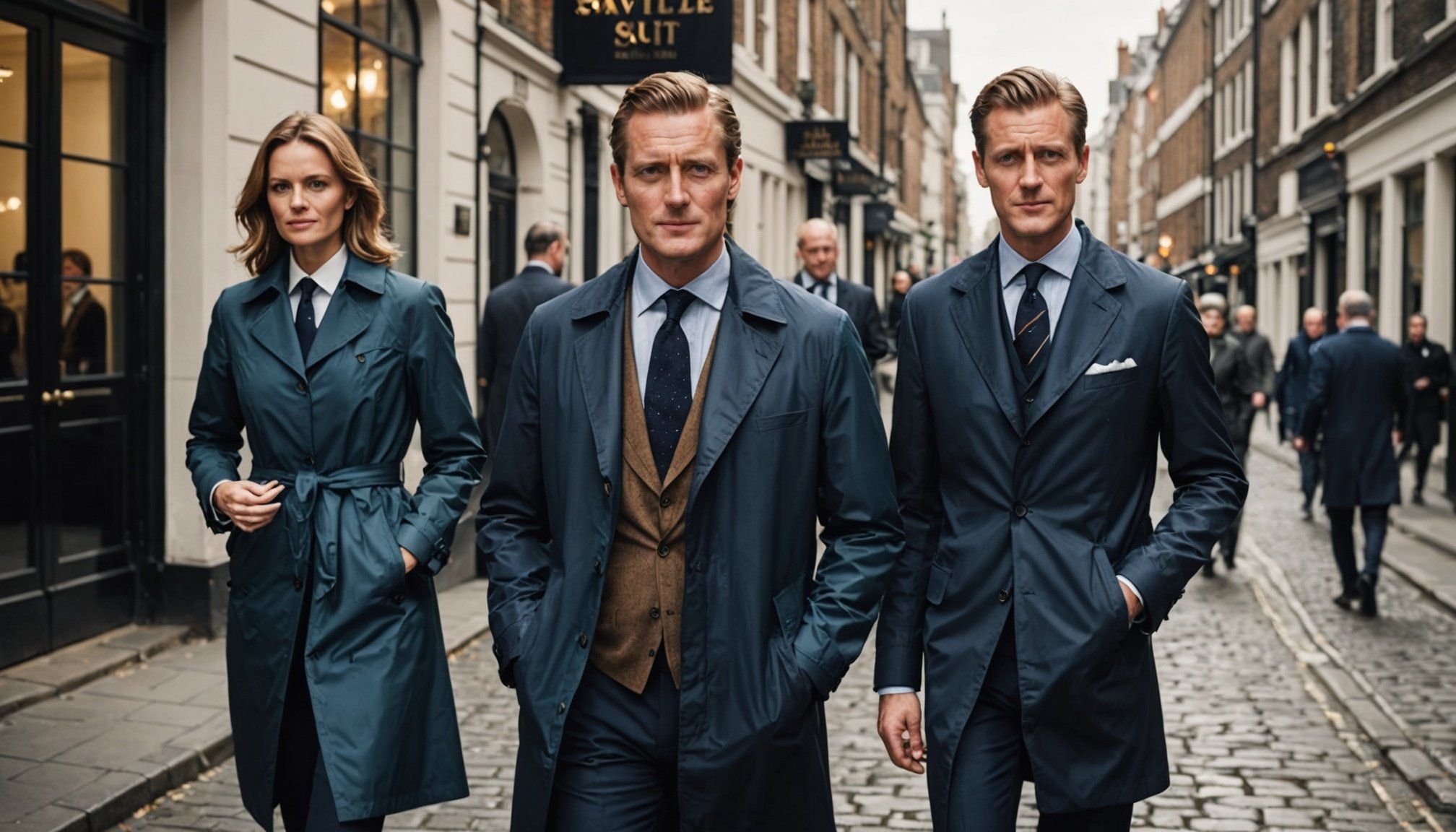Selecting the Perfect Raincoat for UK Weather
Choosing the right raincoat for UK weather involves several considerations, as the climate is notoriously unpredictable. A reliable raincoat should be equipped with key features to handle sudden downpours and varying temperatures.
First and foremost, waterproof materials are essential. Fabrics like Gore-Tex, eVent, and polyurethane-coated nylon are top choices, known for their excellent waterproofing capabilities. These materials prevent water from penetrating the coat while ensuring durability in harsh conditions.
Topic to read : Dressed to Impress: The Definitive UK Polo Match Style Handbook
Breathability is another important aspect to consider. In the UK, it is quite possible to experience humid and wet conditions simultaneously. Fabrics with breathable membranes help regulate moisture inside the raincoat, reducing clammy discomfort from perspiration. This feature is particularly beneficial during milder, rainy days.
Additionally, lightweight insulation can be crucial for staying warm without overheating. Options like lightweight synthetic insulation provide warmth without excessive bulk, making the raincoat versatile for various climates.
Have you seen this : Blending Eras: Creating a Unique British Style with Vintage Charm and Modern Flair
Lastly, consider the overall fit and design for practical use and style. Adjustable hoods, cuffs, and hemlines improve the functionality of the raincoat, accommodating layers underneath. By keeping these elements in mind, you can confidently select a raincoat that withstands the unique demands of UK weather while ensuring comfort.
Styles of Raincoats
Raincoat styles are abundant, catering to both fashionable rainwear and functional outerwear needs. Selecting a style that aligns with your personality and usability is crucial. The classic trench coat, for instance, elegantly balances style and weather resistance. Originally crafted for military officers, its waterproof fabric and knee-length design offer a chic and sophisticated look, suitable for formal occasions.
Meanwhile, the anorak, typically made from waterproof or water-resistant materials, is a pullover jacket with a hood. It’s perfect for outdoor enthusiasts or casual settings due to its sporty, functional appearance. Anoraks often feature drawstrings for adjustable fit and extra protection.
The parka is another popular choice, known for its insulation and warmth. Ideal for colder environments, it combines fashion and comfort with its long length and hood with fur. Parkas are especially handy for combating harsh UK winters.
When balancing style and functionality, consider contemporary trends that align with your wardrobe. Opt for raincoats in on-trend colours or patterns. Whether opting for a chic trench or a cosy parka, today’s raincoat can be a statement piece, ensuring you remain stylishly prepared for any weather the UK throws your way.
Ensuring the Right Fit
Achieving the perfect fit for your raincoat is crucial for comfort and performance, especially in the ever-changing UK weather. An ill-fitting raincoat might leave you vulnerable to wind and rain or cause unnecessary discomfort. Therefore, understanding how to select the right size is essential for optimal functionality and style.
Begin with accurate measurements. Measure critical areas like the chest, waist, and hips. This approach ensures your raincoat will fit well over various clothing layers, which is vital given the UK’s unpredictable climate. Pay attention to the sleeve length and ensure it allows for comfortable movement.
Opt for adaptable features—such as adjustable cuffs and hoods—to enhance comfort and protection. These elements accommodate different body types and clothing layering, providing a customisable fit without bespoke tailoring.
If standard sizes don’t meet your expectations, consider professional adjustments. Tailoring can address common fit issues by altering hems, taking in or letting out seams, or adjusting sleeve lengths. This ensures a raincoat that not only protects against the weather but complements your individual style. By investing in the right fit, you enhance the raincoat’s effectiveness and maintain the balance between style and practicality.
Exploring Bespoke Tailoring for Women’s Suits
Bespoke tailoring is a significant facet of women’s fashion, offering unparalleled personalisation and fit for suits. Unlike off-the-rack options, bespoke suits are crafted exclusively for the wearer, allowing for a unique expression of style and comfort. This meticulous process focuses on precise measurements, ensuring the perfect fit for the individual.
The allure of bespoke tailoring lies in its attention to detail, particularly in fit, fabric selection, and personalisation options. Clients are involved in every step, from selecting fabrics to choosing lining and buttons. This results in a garment that reflects personal taste and meets specific needs.
Savile Row, famed for its superior bespoke tailoring craftsmanship, offers women high-quality suits that combine elegance with practical tailoring. This prestigious London street is synonymous with bespoke excellence, drawing clients from across the globe.
When exploring bespoke options, consider the enduring value of personalisation. Bespoke women’s suits not only provide a perfect fit but are also crafted from high-quality materials, ensuring longevity. Investing in a custom suit is a consideration for those seeking bespoke elegance, personalised style, and tailoring expertise not typically found in ready-made options.
Measurements and Fit for Custom Suits
Suit measurements are crucial for achieving the tailored perfection that bespoke suits offer. The custom fitting process begins with precise measurements of the bust, waist, hips, shoulders, and arms. This meticulous approach ensures the suit hugs your body exquisitely without any discomfort or unsightly bunching.
Common fit issues, like excess fabric around the shoulders or a tight waist, are effortlessly resolved by bespoke tailoring. Tailors make subtle adjustments to align with your body’s unique contours, transforming potential hurdles into a harmonious fit. This intimate fitting process is where bespoke truly shines, providing a level of personalisation that truly sets these suits apart from off-the-rack counterparts.
The role of a tailor is pivotal in achieving the perfect fit. Experienced tailors guide clients through the entire process, offering professional insights and adjustments that elevate the suit to an exemplary standard.
In addition, tailors often suggest enhancements, such as additional padding for structured shoulders or altering the jacket length for optimal balance. These adjustments not only ensure that the suit is a perfect expression of personal style but also accentuates the wearer’s physique, guaranteeing comfort and confidence.
Choosing Fabrics for Your Suit
The fabric choice is pivotal in determining both the aesthetic and comfort of a woman’s suit. Selecting the right materials ensures not only a stunning appearance but also a practical wearability tailored to your needs and environment.
Wool is a popular choice, celebrated for its versatility and natural breathability. Wool suits can be worn all year round thanks to their insulating properties, which regulate body temperature in both cold and warm climates. For a more lightweight option, linen is ideal, particularly for use during summertime due to its excellent moisture-wicking properties and airy texture.
Cotton offers a classic feel of comfort and is less formal, ideally suited for business casual settings. It provides a softer look while being durable and highly breathable.
When deciding on fabric, consider the occasion and climate you anticipate encountering. For a formal setting, wool or a wool blend typically offers a polished finish. Alternatively, for warmer environments or casual events, linen or cotton provides ease and elegance. By choosing fabrics that align with your lifestyle and occasions, you can ensure your bespoke suit remains both functional and fashionable.
Cost Considerations in Bespoke Suits
Understanding the cost of bespoke suits is essential when investing in custom tailoring. Several factors influence the price, from fabric quality to the complexity of the design. Bespoke suits typically command a premium due to their personalised nature and the expertise behind their creation.
Fabric choice plays a significant role in determining cost. High-end materials like Italian wool and cashmere increase the price compared to more conventional fabrics. Similarly, the intricacy of the design, including unique detailing or complex patterns, can add to the overall expense.
Average price ranges for bespoke suits can vary, with basic options starting from several hundred pounds, while more luxurious options can reach into the thousands. Tailoring craftsmanship, particularly from prestigious areas like Savile Row, often justifies the higher pricing, as these are suits made to last.
When budgeting, consider the long-term benefits of investing in a bespoke suit. Unlike off-the-rack garments, a well-crafted bespoke suit offers exceptional fit and durability, making it a valuable addition to any wardrobe. Financially, it might seem like a hefty initial outlay, but the longevity and timeless style it provides can prove cost-effective in the long run.








